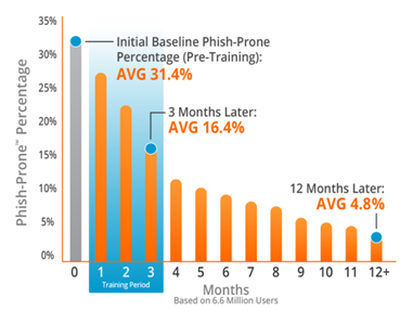Email is the most used form of business communication. It is imperative that existing email data remains confidential when sending and receiving mail. A single wrong click can cause a data breach by exposing company information such as financial statements, contracts, negotiations, etc. Therefore, email security is crucial to understand within both professional and personal environments. Today, we are going to discuss why email security should not be ignored, metrics that show proof that user security training significantly reduces your business' risk, and how Mnemonix can help ensure you and your business stay secure.
With upwards of 90% of attacks on organizations starting from a malicious email, email protection is one of the most important security risks that businesses are presented with. We’d like to revisit the top threats to email and overall network security. The following is a short list we composed in a previous blog that explains different threats to an organization’s email security:
Luckily, there are training platforms and modules that use metrics to track users’ likelihood of partaking in an unknowing malicious action while using email. As you can see in the graph below, the likelihood of accidentally clicking a malicious link, or falling for a fake email, drops significantly with the proper training.
Mnemonix is happy to assist with getting training setup and configured for you and your business. Training your users to be prepared for malicious email attempts is significantly cheaper than the risk of falling victim to a data breach or ransomware. If you or your business would like to know more about the successful, data proven training program to keep you and your business safe, please reach out.
With upwards of 90% of attacks on organizations starting from a malicious email, email protection is one of the most important security risks that businesses are presented with. We’d like to revisit the top threats to email and overall network security. The following is a short list we composed in a previous blog that explains different threats to an organization’s email security:
- Phishing Attacks
- According to statistics cited by TechRadar, there are at least 3.4 billion fake emails sent out as a part of a phishing scam every day. These phishing attacks will send emails that contain fake links and attachments in hopes to get you to click on them. Once clicked, malicious software can be installed, or you could be redirected to a fake website where they may try to collect your login information.
- Spear Phishing Attacks
- Spear Phishing attacks are a specific subset of attacks that are highly customized and targeted to a specific individual or organization. These attacks will typically mimic the tone and style of an organization’s official communications, incorporate copies of the organization’s letterhead and logo, and use the same or similar email domain of the organization. These attacks are a major threat because they can trick even the experienced individuals into making mistakes.
- Weak Email Passwords
- Weak email passwords are another common way that emails get hijacked. Attackers simply guess the account’s password, and if there is no multi-factor authentication enabled, they can get logged in. Accounts that have a weak or easy password can be hijacked without the user knowing – then get used to send out phishing emails from a legitimate company address. According to the 2019 DBIR, about 80% of attacks made users compromised due to weak passwords.
- Malicious Download Links and Attachments
- Many phishing attack emails include links or attachments that are primed with malware. Different types of malware can be used with different kinds of results. Ransomware will encrypt all the data on the affected computer’s drive and/or network if it is connected with elevated rights. Attackers will then demand a payment for the encryption key. Other malware programs may simply sit on the individual’s device and collect information such as login data, financial data, and patterns of communication to use or transmit to an offsite server for an attacker to collect later.
Luckily, there are training platforms and modules that use metrics to track users’ likelihood of partaking in an unknowing malicious action while using email. As you can see in the graph below, the likelihood of accidentally clicking a malicious link, or falling for a fake email, drops significantly with the proper training.
Mnemonix is happy to assist with getting training setup and configured for you and your business. Training your users to be prepared for malicious email attempts is significantly cheaper than the risk of falling victim to a data breach or ransomware. If you or your business would like to know more about the successful, data proven training program to keep you and your business safe, please reach out.


 RSS Feed
RSS Feed
